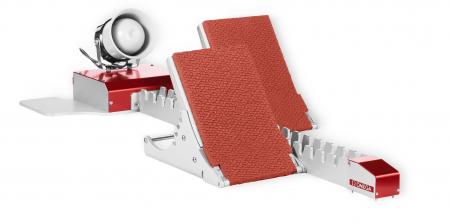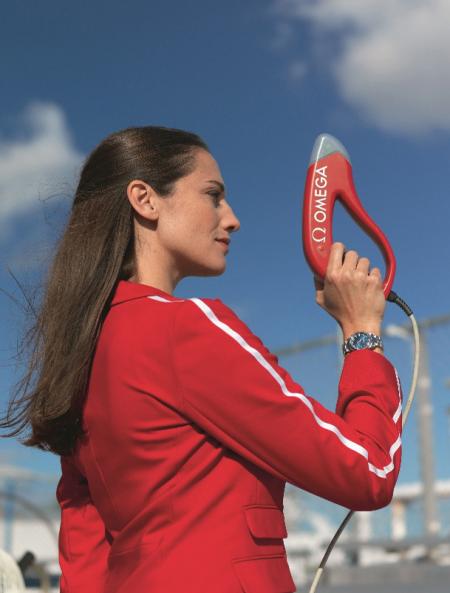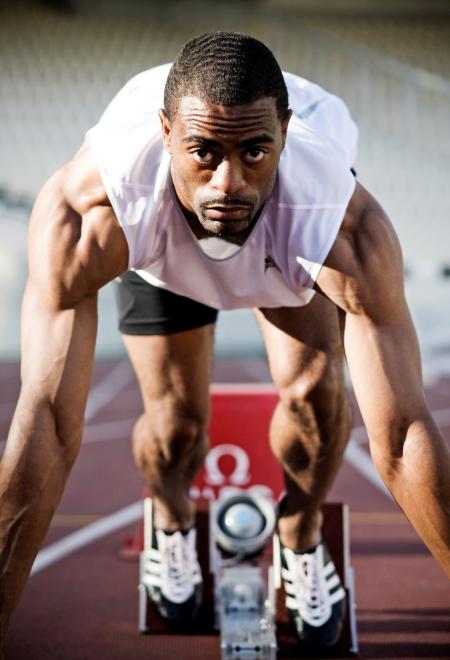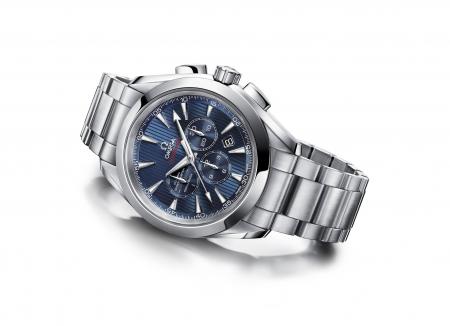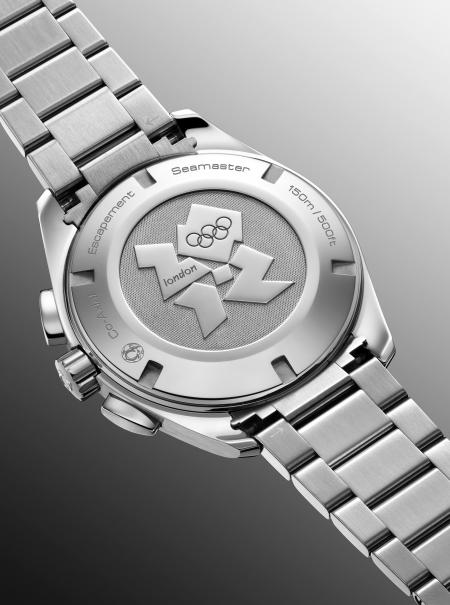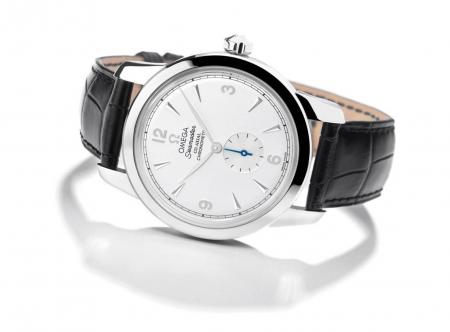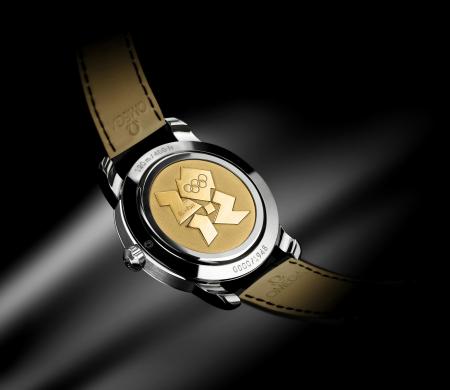Omega invents new technologies timing for London Olympics Games
By MyWatch
OMEGA’s timekeeping and data handling team will draw on the experience gained at 24 Olympic Games and the competence which has given the brand an unparalleled reputation as a precision sports timekeeper.
NEW TIMEKEEPING TECHNOLOGIES AT THE LONDON 2012 OLYMPIC GAMES
The Swiss watchmaker OMEGA is, not surprisingly, obsessed with time. The brand’s 164-year legacy includes countless precision records, conquests of space and the oceans’ depths and, of course, sports timekeeping.
Every Olympic Games features some technological premieres.
Here’s a preview of the equipment which will have its debut at the Olympic Games in London:
Quantum Timer
With an enhanced resolution of 1 µs (one millionth of a second) the Quantum Timer and the Quantum Aquatics Timer mark the beginning of a new generation of OMEGA Timing products. The resolution is 100 times greater than with previous devices. The Quantum also delivers precision of 0.1 parts per million (ppm). This means that there is a maximum variation of only one second out of ten million seconds or a thousandth of a second out of every thousand seconds. The previous devices had precision of 0.5 ppm so in this respect, the new ones are five times as accurate. The precision is achieved through the use of a component created by Micro Crystal, a company of the Swatch Group, which is embedded in the timer.
The OMEGA Timing design team drew on the unrivalled depth of knowledge in timekeeping across the world of sports to produce what will be the heart of many systems.
Innovative features include a complete backup built into the main unit, and with 16 independent clocks, 128 inputs and 32 outputs it will be a challenge to find a sport that Quantum cannot time.
The 16 independent clocks mean that 16 separate running times can be physically implemented in the hardware and the information for each can be simultaneously communicated to scoreboards or shown on television screens. The same technology that allows the Quantum Timer to redefine cycling track timekeeping is also used in the Quantum Aquatics Timer and brings the same great timekeeping performance to water sports.
Athletics Starting Block
OMEGA is also introducing an updated athletics starting block at the London 2012 Olympic Games. The runners’ reaction times are measured entirely by the measurement of force against the back block and not by movement. The new blocks can detect the reaction times of every runner – from children through world-class sprinters – without changing any settings on the device.
The central bar is thinner than that of the previous device allowing better starting positions for women and children. It has been reduced from 80 to 50 mm. The foot rest is now wider, having been expanded from 120 to 160 mm, allowing different starting positions.
Swimming Show (lights that indicate the three top finishers)
An innovative light system called the Swimming Show will also make its debut at the Olympic Games in London. There are lights mounted on the starting blocks positioned next to the touch pads at the end of the pool where the swimmers stop their races. A single large dot of light on a swimmer’s starting block indicates first place; two medium-sized dots of light indicate second; and three smaller dots of light confirm a third place finish.
The Swimming Show light system was conceived primarily for spectators. They don’t need to look at the main scoreboard to confirm the results; the three top finishers will be clearly identified at the end of the pool. The Swimming Show can also indicate intermediate rankings of the top-three competitors every hundred metres.
Open Water Gate
Among the most challenging of the Olympic disciplines are the men’s and women’s swimming marathon.
OMEGA’s new Open Water Gate is set up not only at the beginning and the end of the race but also in intermediate positions so, at the London 2012 Olympic Games, new timing information will be available. Previously, times were only reported at the beginning and the end of the marathon. Now intermediate times will also be available.
The gate positioned at the finish has touchpads with vertical transponder antennas while the ones in the intermediate positions have horizontal transponder antennas that pick up the signals “on the fly” from the transponders the swimmers wear on their wrists. At the finish, there are also high-definition cameras mounted on poles that serve as a reliable backup system and which are also used when athletes are too close in time and cannot be ranked by the transponder system alone.
FOR THOSE WHO WANT TO LEARN MORE…
OMEGA AND THE LONDON 2012 OLYMPIC GAMES
“The London 2012 Olympic Games has particular significance to Omega. It marks the 25th time we have assumed our role as Official Timekeeper; we are celebrating the 80th anniversary of our first Olympic Games; and we are returning to the city that, with the introduction of photoelectric cells, athletics starting blocks and the slit photofinish camera, saw the birth of modern sports timekeeping in 1948.
For the London 2012 Olympic Games, the people of London have revitalized an entire section of their city and are offering a mix of purpose-built and iconic venues such as Wembley Stadium, Wimbledon, Lord’s Cricket Ground and Greenwich Park among others. No other city in the world could offer such an impressive combination of historic and contemporary locations for an Olympic Games. OMEGA looks forward to timing and measuring each event at every venue. We value our partnership with the International Olympic Committee and are proud to be at the service of the talented athletes who make the Olympic Games the world’s highest-profile sporting event. This association with the IOC has resulted in the development of some of the most significant innovations in timekeeping and data handling technology.
As with every Olympic Games, OMEGA is introducing new timekeeping innovations in London. While the technology offers greater flexibility in the distribution, display and storage of the results, it has the same aim as the chronograph stopwatches that were used to time each event at our first Olympic Games in 1932: to record for posterity the extraordinary performances of the world’s best athletes.”
Stephen Urquhart
President of OMEGA
OMEGA COUNTDOWN CLOCKS IN TRAFALGAR SQUARE AND IN GREENWICH
The London Organising Committee of the Olympic Games and Paralympic Games (LOCOG) and OMEGA, Official Timekeeper for the London 2012 Games, unveiled on March 14th 2011 the Countdown Clock in Trafalgar Square.
The design of the Clock reflects the look of the Games. The beams of light on the Clock are inspired by London and its connection with the Meridian line in Greenwich, the home of time. Trafalgar Square was chosen as the setting for the Clock as it is one of London’s most recognisable landmarks and iconic locations, visited by millions of Londoners and tourists each year. It was the centre of celebrations when London won the bid and will once again play a key part in the build-up to the London 2012 Games.
The Clock is made from steel from a Preston-based company. It is 6.5 metres high, 5m long and weighs around 4 tonnes. The Clock took 10 people two days to assemble in the square. The lighting designs on the Clock were created by a British company.
LOCOG Chair Seb Coe said: ‘The launch of the OMEGA Countdown Clock is an important milestone for any Olympic Games and is something of a tradition within the Olympic Movement. It will be a daily and hourly reminder to everyone who visits Trafalgar Square that the countdown to the start of London 2012 has well and truly begun and that the greatest show on earth is soon coming to our country.
‘Athletes’ careers are based on timing and I hope that this milestone moment excites and inspires them to compete at the highest level in 2012. Athletes hoping to compete in the Olympic Games are in the final stretch of their preparation and the next 500 days will be crucial to them as their dream of competing in a Games comes closer to reality.’
OMEGA’s Stephen Urquhart said that his company is looking forward to returning to London again to time the Olympic Games for the first time in 64 years. He said: ‘In 1948, the last time the Olympic Games were held in this city, OMEGA was responsible for timing each discipline in every sport. That edition of the Games is remembered for the technological milestones in timekeeping: the photoelectric cell, our fully-automated timing system and the first photofinish camera ever used at an Olympic Games. Then, as now, we were proud to be at the service of the International Olympic Committee and the world’s great athletes.’
Mayor of London Boris Johnson said: ‘The countdown begins right now in the very heart of the capital as we gear up to stage the best Games in living memory and the excitement spreads outwards from Trafalgar Square to every corner of our great city. In 500 days time the atmosphere will be electric as the Olympic cauldron bursts into flames signalling the beginning of the world’s greatest sporting event and London 2012’s glorious legacy unfolds.’ A second official OMEGA Countdown Clock, has been unveiled in time in Greenwich to celebrate “One Year to Go” to the start of the Games on the 27th July 2011. Ticking away the seconds, minutes, hours and days until the excitement begins is the Countdown Clock installed right on the Prime Meridian Line.
HIGHLIGHTS OF TIMEKEEPING AT THE OLYMPIC GAMES
At the Olympic Games in London, OMEGA, the Official Timekeeper, will bring its century-long history of international sports timing and a legacy at the Olympic Games which began in 1932.
OMEGA’s timekeeping and data handling team will draw on the experience gained at 24 Olympic Games and the competence which has given the brand an unparalleled reputation as a precision sports timekeeper.
Here is a short review of some of OMEGA’s timekeeping highlights at the Olympics.
1932
1932 was a defining moment in the history of sports measurement: Omega became Official timekeeper at the Los Angeles Games in 1932, supplying 30 high precision chronographs, all of which had been certified as chronometers by the Observatory at Neuchâtel, for use across all sports. It was the chronographs’ officially certified precision which convinced the Olympic Organizing Committee of the Olympic Games to select Omega for the Games. Official results were taken at fifths and tenths of a second.
1936
For the Olympic Games in Berlin, 185 chronographs were taken from Bienne to the German capital in a suitcase carried by 29-year-old Omega watchmaker Paul-Louis Guignard. At the Berlin 1936 Games, the great Jesse Owens (USA) memorably won four gold medals in the days when athletes dug their own starting holes with small shovels.
1948
Omega used the cellular photoelectric eye for the first time at the 1948 Olympic Winter Games in St. Moritz. Mobile and independent of the electrical network, it was water-resistant and could be adjusted to resist wide variations in temperature; its infrared technology was insensitive to the so-called parasitic reflection of the sun and flashes. For the first time, the timing system was triggered automatically when the starting gate opened.
For the Olympic Games in London, the British Race Finish Recording Co. Ltd developed the first photo-finish camera, dubbed the ‘Magic Eye’, with its continuous image and a recorded speed which could be modulated according to needs of the sport being practiced, from rowing to cycling. It worked in tandem with Omega timing equipment. It was at this Olympiad that machines began to out-perform human beings for accuracy.
1952
Capable from this point forward of showing hundredths of a second below the images of athletes crossing the finish line, the Racend Omega Timer succeeded the Magic Eye in 1949, and was renamed the Photofinish in time for the 1952 Olympics. The era of quartz and electronics had arrived, above all with the Omega Time Recorder, mobile and independent of the electrical network, which allowed the results to be printed out on a roll of paper, winning Omega the prestigious ‘Croix du Mérite Olympique’. Official times were now recorded to the nearest hundredth of a second.
1956
Starting gates were used for the first time in Alpine skiing at the 1956 Winter Games in Cortina d’Ampezzo, Italy. The start time was automatically triggered by an acoustic traffic-light signal, the buzzer timed to the red – yellow – green countdown. The most spectacular innovation was seen in the Melbourne pool at the Summer Games: the Swim Eight-O-Matic Timer, the first semi-automatic timekeeping device for swimming, with digital display, allowed timekeepers to distinguish between two individual swimmers who finished at virtually the same time.
1960
A controversial result at the 1960 Summer Games in Rome, the last Olympic competition timed by Omega to be resolved with a human-eye decision, triggered the next big innovation in the pool: automatic touch pads, also invented by the Biel-based manufacturer, which wouldn’t, however, be competition-ready until 1967 for the Pan-American Games in Winnipeg.
1964
Invented in 1961, the Omegascope allowed the introduction of the concept of real time in televised sports reporting by superimposing luminous numbers on the bottom of the screen; it revolutionized timekeeping and left no margin for error because it was openly on display for millions of TV viewers. It was used at the 1964 Olympic Winter Games in Innsbruck, the first fully electronic Olympic Games. Never before had spectators beyond a venue been so quickly and well informed about events taking place elsewhere.
1968
‘Integrated timing’ was introduced at the Games in Grenoble and Mexico City, where automatic and electronic timekeeping was used for the first time, providing statistical analysis with results being fed to judges, coaches, media and, to some degree, the public. The birth of the photoprinter ensured that results were more rapidly and widely distributed than ever before. The concrete realization of modern timekeeping was a historic turning point for OMEGA.
The most talked-about technology was the touch pad in the pool which allowed the swimmer’s own hand to stop the clock, eliminating the need for poolside timekeepers.
Also, a loudspeaker linked to the starting signal and placed behind each starting block meant that all swimmers would hear the start signal at the same moment. The Swim-O-Matic, successor to the Swim Eight-O-Matic, was accurate to the nearest thousandth of a second but it would not be until 1972 that the full potential of the system was put into practice – and then only for one race.
1972
Spectators in Munich witnessed the controversy of the first and only gold medal in the pool ever to be awarded on the basis of thousandths of a second which forced a change in rules. In the 400-metre medley, Gunnar Larsson, the double European champion from Sweden, and Tim McKee (USA) stopped the clock at 4:31.98. Officials then declared Larsson the champion: 4:31.981 to 4:31.983. Days later, the FINA rulebook was changed to declare that times would only be measured to a hundredth of a second.
1976
One of the most memorable moments came when Nadia Comaneci’s perfect score of 10.0 appeared as 1.00 on the scoreboard which wasn’t equipped to deal with a flawless performance – but everyone knew exactly what had just taken place.
1980
The Omega Game-O-Matic, which calculated and displayed an athlete’s ranking the moment he or she crossed the finish line, was used for the first time at the Winter Games in Lake Placid.
At the Olympic Games in Moscow, the new version of the Swim-O-Matic was a chronometer briefcase that weighted only 1.2 kg, compared to the whopping 150 kg of its 1976 predecessor.
1984
The Olympics in Los Angeles were the first to feature colour photofinish images whose paper prints signed by the athletes were highly prized. 1984 also saw the Olympic début of Omega’s false-start detectors.
Timekeeping accuracy was responsible for the first shared gold in Olympic swimming history: Americans Carrie Steinseifer and Nancy Hogshead both clocked 55.92 seconds over the 100-metre freestyle.
1988
Calgary and Seoul were the first Olympic Games with computerised timekeeping, results and analysis stored in databases for posterity. The Omega video matrix board boasted colour images in Seoul.
1992
At the 1992 Winter Games in Albertville, speed skaters were treated to the Omega Scan-O-Vision system that digitally measured times to the nearest thousandth of a second as the skaters crossed the finish line. The system effectively photographed time by fusing time and continuous picture in a single document. This heralded a new chapter in the science of timekeeping.
1996
The Atlanta 1996 Olympic Games saw the inauguration of the first “global” Olympic timekeeping which realized, for each sport and every discipline, the timekeeping trilogy: timekeeping, data handling, and distribution of the results. Following the introduction of the Omegascope in 1961 and the integrated timekeeping at the Olympic Games in 1968 in Mexico City, it represented the third major stage in modern timekeeping. Over at the sailing regattas in Savannah, the global positioning system (GPS) was one of 20 innovations that Swatch introduced in Atlanta. In athletics, acceleration and running speed were measured in sprint events, the data proving that the Olympic 100-metre champion Donovan Bailey was last out of the blocks but won by having the greatest acceleration, and the consistently highest speed to the finish line.
2000
2000 saw the introduction of Omega’s Live Timing at www.omegatiming.com. Within 15 seconds of a swimmer touching the pad, a complete set of splits, a ranking, and information on records was available to a global audience to read and download on the Internet. Technology allowed TV viewers to see a line across the picture that indicated how close athletes were to world records in some sports.
2004-2006
The radar gun, which had already been used at tennis events, made its debut at the beach volleyball events at the 2004 Olympic Games in Athens. At the Winter Games in Turin in 2006, transponders were strapped to the ankles of speed skaters so that timekeepers might capture a moment of sudden acceleration, the speed round a hairpin bend, the abrupt end to a challenge as a racer crashed to the ice.
2008
In Beijing, among the many improvements to the world of sports timekeeping were high-speed cameras along with new timing, scoring and false start systems. GPS systems and bib transponders were also used to great effect. This edition of the Games will long be remembered for the 100-metre butterfly when Michael Phelps defeated the silver medallist by a hundredth of a second – the smallest possible margin in a swimming event. The result was initially disputed but the high-speed video camera backup system confirmed that OMEGA’s electronic timing system had worked perfectly.
2010
The most talked-about bit of new sports timekeeping equipment In Vancouver was the new Electronic Start System. One of the most enduring images from any Olympic Games is the starting pistol, reminiscent of the revolvers so popular in movies set in the Old West. At Olympic and Paralympic Winter Games, this was replaced by a streamlined, futuristic device composed of a flash gun and a sound generation box. When the starter presses its trigger, three things happen simultaneously: a sound is “played”, a light flash is emitted and a start pulse is given to the timing device. By pressing the trigger a second time within two seconds, the false start is audibly signalled. The sounds can be changed and downloaded by computer.
2012 and beyond
At each Olympiad, OMEGA’s timekeeping professionals refine and redefine the art and science of world-class sports timing. There’s no doubt that they will continue to set milestones at the Olympic Games in London in 2012, Sochi in 2014 and beyond. OMEGA and the IOC recently extended their agreement through the 2020 Olympic Games.
OMEGA AND THE OLYMPIC GAMES
As the OMEGA Countdown Clocks in Trafalgar Square and Greenwich continue to tick away the seconds till the beginning of the Opening Ceremony of the London 2012 Olympic Games, OMEGA’s timekeeping and data-handling professionals are actively involved in preparations for the competition where, for the 25th time, the Swiss specialists will serve as Official Timekeepers at the Olympic Games. On the 29th of August, they will assume the same role at the Paralympic Games.
At OMEGA’s first timekeeping assignment for the Olympic Games in Los Angeles in 1932, only thirty chronograph stopwatches were used to time each event at the Games.
Eighty years later in London, OMEGA will deploy more than 450 professional timekeepers and data handlers supported by nearly 400 tonnes of equipment and a large contingent volunteers recruited by LOCOG and trained by OMEGA.
The Games in London will take place over a 17-day period beginning on the 27th of July. Some 10,500 Olympic Games athletes and officials from more than 200 countries will make it among the largest Olympic Games ever. The Paralympic Winter Games, for which OMEGA is also Official Timekeeper, start on the 29th of August and will continue for ten days. The Games’ organisers anticipate that the London 2012 Paralympic Games will attract more than 4000 athletes and officials from around 160 countries.
1948-2012: THE EVOLUTION OF TIMEKEEPING EQUIPMENT
The London 1948 Olympic Games ushered in the era of modern sports timekeeping. A number of the ground-breaking innovations introduced at that edition of the Games are a part of our contemporary timekeeping efforts. Some are remarkably similar to their ancestors while others have changed conspicuously. In either case, the goal is the same: to deliver the best possible timekeeping service to the world’s finest athletes.
Photoelectric cells
In 1948, OMEGA’s photoelectric cells made their Olympic Games debut and while their appearance has changed over the years, the function and performance of the contemporary version are similar to that of those launched in 1948 (the speed of light has remained fairly consistent over the years). In 1948, there was a photoelectric cell with a combined sender and receiver on one side of the track and a reflective mirror on the other. When the light beam was broken between the cell and the mirror, the time was recorded. From the next edition of the Games, the sender and receiver were separated and placed on opposite sides of the track for more effective performance in the case of grouped finishes.
Start pistols
An enduring image from past sporting events is the starting pistol, reminiscent of the revolvers so popular in movies set in the Old West. At the Vancouver 2010 Olympic and Paralympic Winter Games, this was replaced by a streamlined, futuristic device composed of a flash gun and a sound generation box.
With the new device, when the starter presses its trigger, three things happen simultaneously: a sound is “played”, a light flash is emitted and a start pulse is given to the timing device. By pressing the trigger a second time within two seconds, the false start will be audibly signalled. The sounds can be changed and downloaded by computer.
As was the case with traditional powder pistols, the sound is reproduced by speakers near each competitor, guaranteeing that they hear the signal at the same time. At some venues, the audio signals are also put on the public address system. The new electronic starter offers another practical advantage over the traditional starting pistol: it causes less consternation at airport security checkpoints.
Athletics starting block
The London 1948 Olympic Games, starting blocks were used for the first time in athletics. At the previous edition of the Games in 1936, sprinters like the legendary Jessie Owens dug their own starting holes! The starting blocks introduced in 1948 ensured that the conditions were identical for every competitor.
At the London 2012 Olympic Games, OMEGA is introducing an updated athletics starting block. The runners’ reaction times are measured entirely by the measurement of force against the back block and not by movement. The new blocks can detect the reaction times of every runner – from children through world-class sprinters – without changing any settings on the device.
Touch pads in swimming pools
Among the more conspicuous timekeeping innovations are the touch pads that are now such a familiar site at the end of each competitor’s lane in the swimming pool. The need for the kind of precision provided by the touch pads became especially clear at the Rome 1960 Olympic Games. In those days, three judges were assigned to watch each lane in the swimming events. That year, in the men’s 100-metre freestyle, the American Lance Larson and the Australian John Devitt finished at almost exactly the same time. The stopwatches held by the timekeepers watching Larson recorded 55.0, 55.1 and 55.1 seconds. Devitt’s times were all 55.2 seconds.
A clear result, right? Not exactly.
There were also three first-place judges and three second-place judges. Two of the first-place judges thought Devitt had won and only one favoured Larson. However, two of the second-place judges thought that Devitt had been the runner-up and only one thought Larson was runner-up.
The judges were divided 3-3 and they asked for the advice of the chief judge. He decided in favour of Devitt and ruled that the times should be ignored. Larson’s time was rounded up to 55.2 seconds. Official protests were filed, but the ruling was upheld.
The strangest part: John Devitt remained the official Olympic champion but Lance Larson’s time of 55.1 seconds was declared the Olympic record. Therefore, the runner-up had swum faster than the champion.
It was clear that an automatic system was needed and OMEGA introduced the touch pads at the Pan-American Games in Winnipeg, Manitoba in 1967. Their Olympic debut was at the 1968 Mexico City Olympic Games in 1968 and they have been used at every Olympic Games since.
NEW TIMEKEEPING TECHNOLOGIES AT THE LONDON 2012 OLYMPIC GAMES
The Swiss watchmaker OMEGA is, not surprisingly, obsessed with time. The brand’s 164-year legacy includes countless precision records, conquests of space and the oceans’ depths and, of course, sports timekeeping. Every Olympic Games features some technological premieres. Here’s a preview of the equipment which will have its debut at the Olympic Games in London:
Quantum Timer
With an enhanced resolution of 1 µs (one millionth of a second) the Quantum Timer and the Quantum Aquatics Timer mark the beginning of a new generation of OMEGA Timing products. The resolution is 100 times greater than with previous devices. The Quantum also delivers precision of 0.1 parts per million (ppm). This means that there is a maximum variation of only one second out of ten million seconds or a thousandth of a second out of every thousand seconds. The previous devices had precision of 0.5 ppm so in this respect, the new ones are five times as accurate. The precision is achieved through the use of a component created by Micro Crystal, a company of the Swatch Group, which is embedded in the timer.
The OMEGA Timing design team drew on the unrivalled depth of knowledge in timekeeping across the world of sports to produce what will be the heart of many systems.
Innovative features include a complete backup built into the main unit, and with 16 independent clocks, 128 inputs and 32 outputs it will be a challenge to find a sport that Quantum cannot time.
The 16 independent clocks mean that 16 separate running times can be physically implemented in the hardware and the information for each can be simultaneously communicated to scoreboards or shown on television screens. The same technology that allows the Quantum Timer to redefine cycling track timekeeping is also used in the Quantum Aquatics Timer and brings the same great timekeeping performance to water sports.
Athletics Starting Block
OMEGA is also introducing an updated athletics starting block at the London 2012 Olympic Games. The runners’ reaction times are measured entirely by the measurement of force against the back block and not by movement. The new blocks can detect the reaction times of every runner – from children through world-class sprinters – without changing any settings on the device.
The central bar is thinner than that of the previous device allowing better starting positions for women and children. It has been reduced from 80 to 50 mm. The foot rest is now wider, having been expanded from 120 to 160 mm, allowing different starting positions.
Swimming Show (lights that indicate the three top finishers)
An innovative light system called the Swimming Show will also make its debut at the Olympic Games in London. There are lights mounted on the starting blocks positioned next to the touch pads at the end of the pool where the swimmers stop their races. A single large dot of light on a swimmer’s starting block indicates first place; two medium-sized dots of light indicate second; and three smaller dots of light confirm a third place finish.
The Swimming Show light system was conceived primarily for spectators. They don’t need to look at the main scoreboard to confirm the results; the three top finishers will be clearly identified at the end of the pool. The Swimming Show can also indicate intermediate rankings of the top-three competitors every hundred metres.
Open Water Gate
Among the most challenging of the Olympic disciplines are the men’s and women’s swimming marathon.
OMEGA’s new Open Water Gate is set up not only at the beginning and the end of the race but also in intermediate positions so, at the London 2012 Olympic Games, new timing information will be available. Previously, times were only reported at the beginning and the end of the marathon. Now intermediate times will also be available.
The gate positioned at the finish has touchpads with vertical transponder antennas while the ones in the intermediate positions have horizontal transponder antennas that pick up the signals “on the fly” from the transponders the swimmers wear on their wrists. At the finish, there are also high-definition cameras mounted on poles that serve as a reliable backup system and which are also used when athletes are too close in time and cannot be ranked by the transponder system alone.
OMEGA’S BRAND AMBASSADORS IN LONDON
At the Games of the XXX Olympiad in London this year, the eyes of the world will be focused on the some incredibly talented sportsmen and women. OMEGA is proud to count several athletes among its ambassadors. Some are already Olympic legends; the others are looking forward to joining their ranks.
Michael Phelps
Michael Phelps is the quintessential OMEGA ambassador. Since 2004, his enormous popularity and success have allowed him to bring a human face to the values of the brand.
The facts speak for themselves: Michael won eight gold medals at the Beijing 2008 Olympic Games, setting seven world records and one Olympic mark in the process. Four years earlier in Athens, he had won six gold medals and two bronzes, so his Olympic total is a breath-taking 16 gold medals and two bronzes.
Asked about how his performance in Beijing has changed his sport, Michael says, “I think one of the coolest things I have seen is that people are actually watching swimming now. People know our names. People are out there cheering for us.” He adds, “It is always fun for me to watch the young kids growing up in the sport. They are going to experience everything we are going through plus even more.
That is kind of cool to be able to try to think about what it could be for them five or ten years down the road.”
The expectations placed on someone who has enjoyed Michael Phelps’s level of success are enormous. Will he be able to cope with at the London 2012 Olympic Games? No one is betting against him.
Chad le Clos
Chad le Clos, the 20-year-old South African swimming sensation, has joined OMEGA’s family of brand ambassadors. Chad made a strong impression on OMEGA at the inaugural Youth Olympic Games in Singapore in 2010 when he collected five medals. In the same year he claimed gold in the 200-metre butterfly and the 400-metre individual medley at the Commonwealth Games, setting Games records in both events. At the FINA World Short Course Championships in 2010, he won the gold medal in the 200-metre butterfly.
Chad is looking forward to his first Olympic Games and says, “On my 17th birthday in 2009, when I qualified for the World Championships in Rome, I swam a 4:16 400 individual medley and from that day on, I believed I could be in the Olympic Games. I’m confident about what I can achieve but it’s going to be the biggest competition of my life. I’ll focus on one race at a time.”
Jessica Ennis
Jessica Ennis, the 26-year-old British sports star, is one of the dominant athletes of her generation having won the World and European Championships in the heptathlon as well as a World Indoor Championship in pentathlon.
Prevented by injury from participating in the Beijing 2008 Olympic Games, Jessica has been preparing herself for the Olympic stage for many years and is eagerly anticipating the Games in London. She says, “I’ve been preparing all my life to compete in an Olympic Games. Although year on year you prepare for upcoming championships, it’s every athlete’s dream to compete at this level – it is always the long-term goal. And for it to be at a time of a home Olympics is unbelievably special.”
Asked about her feeling before a top level competition, she says, “I imagine that before my Olympic event I will be washed with nerves, adrenaline and excitement. I know from previous major championships that that is always the case. It’s a strange feeling before you compete as this is your one moment to put all that training into practise, all that you have worked so hard towards for the past few years and it all comes down to those very short moments.”
Tyson Gay
Tyson Gay is one of the most talked-about athletes in the world and his triple World Championships in 2007 placed him prominently on the world track and field map. In the time leading up to the 2008 Beijing Olympic Games, the world’s sporting media and track and field fans were focused on Tyson’s every move – his wind-aided 9.68 second performance in the 100-metre trials was the fastest time ever recorded for the distance.
As a result, when his campaign was thwarted by a dramatic injury in the 200 metre at the Olympic trials, the disappointment was particularly intense. Nevertheless, the charismatic and popular sprinter described his experience in Beijing “the best time of my life” for the people he met and for the warm reaction of the fans both in the stadium and around the world.
It is Tyson Gay’s optimism and mental attitude which have allowed him to return to the track enthusiastically, firm in his conviction that his best times are still ahead of him.
Asked to compare competing at an Olympic Games with other major sporting events, Tyson says, “Competing at the Olympic Games is different because of the long history behind the Games and what they’ve grown to become – the biggest sporting event in the world. Since it is only every 4 years for a summer athlete, I find it more exciting and interesting. Nothing compares to the feeling of adrenaline you get when you walk into that Olympic Stadium.”
He says that the psychological and physical demands of Olympic competition are extraordinary: “My mental state was hyper-focused during my last Olympic experience. My nerves were crazy and since my mind would not shut off it was very hard to sleep that night before. I have since learned how to manage emotions and nervousness of big races so I use all my energy for the race and not before.”
THE OMEGA SEAMASTER AQUA TERRA OLYMPIC COLLECTIONCELEBRATING AN ENDURING PARTNERSHIP
To commemorate its role as Official Timekeeper of The Olympic Games, OMEGA has introduced special editions of its Seamaster Aqua Terra collection with distinctive blue dials. The Aqua Terra wristwatches, with the unmistakable vertical lines on their dials, are among the brand’s most popular products and the watches in the Olympic Collection will be cherished keepsakes from the London 2012 Olympic Games.
– The OMEGA Seamaster Aqua Terra Co-Axial Chronograph “London 2012”
– The OMEGA Seamaster Aqua Terra Co-Axial “London 2012”
– THE OMEGA SEAMASTER 1948 CO-AXIAL “LONDON 2012” LIMITED EDITION
